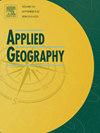Traditions and entrepreneurial spirit: The evolving geography of craft brewing in Romania and dynamic interactions with the local development environment
IF 4
2区 地球科学
Q1 GEOGRAPHY
引用次数: 0
Abstract
In the complex image of the craft beer movement in Central and Eastern Europe, this paper proposes an exploration of the craft beer phenomenon in Romania by means of a mixture of macro and local-level approaches, which bring into the spotlight the location patterns of craft breweries, followed by the contribution of this industry to local growth and its integration into the local ecosystem. The former component is explored mainly by means of statistical data processing and static data visualisation techniques, including geographic mapping to represent spatial distributions, while the latter follows a qualitative interview-based investigation. The main results of the research show that Romanian craft breweries capitalise on geographical, cultural, and historical symbols, strengthening local identity, and creating an emotional connection with consumers through evocative branding. In addition, craft breweries focus on short supply chains and local markets, education for healthy consumption, and sustainability. The challenges entailed by production and distribution, changing consumer behaviour, the need to promote sustainable practices for eco-friendly brewing, and the adaptation to polycrisis-related shocks are particularly addressed. Finally, reflections are made on public policies capable of supporting this sector.
求助全文
约1分钟内获得全文
求助全文
来源期刊

Applied Geography
GEOGRAPHY-
CiteScore
8.00
自引率
2.00%
发文量
134
期刊介绍:
Applied Geography is a journal devoted to the publication of research which utilizes geographic approaches (human, physical, nature-society and GIScience) to resolve human problems that have a spatial dimension. These problems may be related to the assessment, management and allocation of the world physical and/or human resources. The underlying rationale of the journal is that only through a clear understanding of the relevant societal, physical, and coupled natural-humans systems can we resolve such problems. Papers are invited on any theme involving the application of geographical theory and methodology in the resolution of human problems.
 求助内容:
求助内容: 应助结果提醒方式:
应助结果提醒方式:


